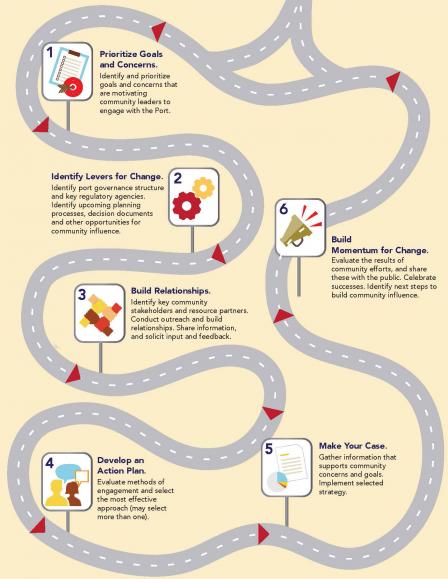Community Action Roadmap Overview
Using the Community Action Roadmap
The Community Action Roadmap outlines six key steps for effectively engaging in local decision-making. As shown in the diagram below, the steps are outlined in a specific order starting with setting goals; however, you may choose to begin at the step that best fits your unique situation. Timeframes for each step will vary depending on local needs and goals, and over time communities may cycle through the steps several times to address new issues and strengthen their local partnerships.
 Community Action Roadmap Diagram
[Click the image to enlarge.]
Community Action Roadmap Diagram
[Click the image to enlarge.]
Selecting a Starting Place
The following scenarios provide examples of how different communities may approach the roadmap.
- Community Collaboration, Scenario A – Your community may have come together around a specific issue, but may be wondering how to build on this initial collaboration to do more. You may choose to start with Step 1 and involve residents and organizations in developing a shared set of priority goals and concerns.
- Community Participation, Scenario B – Your community may be interested in providing public comment on a ports-related issue (e.g., an infrastructure improvement project). You may start at Step 2 by ensuring that community residents are informed about when and how they can provide their input during the decision-making process. Following successful participation in the comment period, you may decide to work towards capturing the community’s interest and momentum by circling back to Step 1 and prioritizing additional community goals for continued engagement.
- Community Partnership, Scenario C – Your community may have spent several years outlining a plan to improve quality of life. However, you are having trouble finding partners and resources to implement your goals. You may choose to enter the roadmap on Step 3 and focus on building partnerships with agencies and organizations that may have the expertise, resources or authority to help you achieve your priorities.
Try it Out!
| Step | Self-Assessment | Mark: no, some or yes |
|---|---|---|
| 1 | Has your community identified and prioritized a set of goals? | |
| 2 | Does your community know the key agencies and decision-making processes that can have the most impact on your goals? | |
| 3 | Does your community have relationships with the key decision-makers, the business community, environmental organizations and a range of community groups that reflect the diversity in your community? | |
| 4 | Has your community evaluated a range of methods for achieving your goal and selected a few that will be most effective? | |
| 5 | Does your community have an action plan and the data, tools and resources to make the case for the changes you want? | |
| 6 | Has your community reflected on past efforts, celebrated successes and determined how to address lessons learned and build on strengths? |









